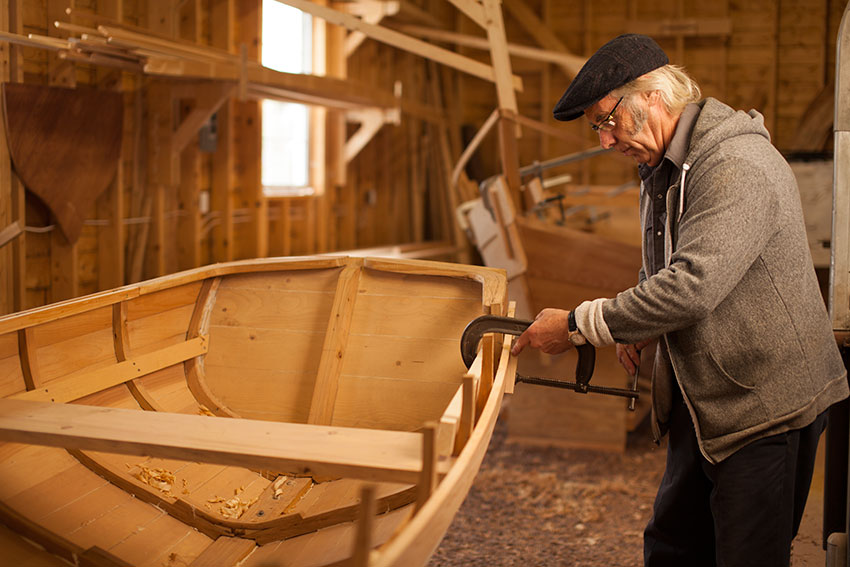
Craft at Risk
Inspired by Canada’s History’s profile of Craft at Risk (Heritage NL), this VisitList highlights historic sites across the country that contribute to documenting, preserving, and continuing traditional craftsmanship practices that are otherwise at risk of being lost. The project consisted of over 60 instructional workshops and training events throughout the province, and also included an immersive apprenticeship program. The project has helped preserve over 20 crafts and helped revitalize a range of skills. The project won the 2023 Governor General’s Award for Excellence in Community Programming. Explore sites committed to showcasing Indigenous arts and culture, traditional craftmanship, printing, and more.
Read the full article from Canada’s History here.
Places
Tilting Registered Heritage District
Fogo Island, Newfoundland and Labrador
Beginning in the 1730s, Irish settlers arrived in Tilting and began to shape the landscape through the construction of houses and fishing rooms to support the inshore fishery. Bringing customs from Ireland, Irish settlers subdivided the land and developed groups of extended family neighbourhoods, as well as maintaining traditions like keeping gardens. Tilting is remarkable as a surviving example of the Irish-Newfoundland cultural landscape. Tilting was designated a National Historic Site of Canada in 2002.
The town features several historic buildings, including the Dwyer Premises, Lane House and the Old Post Office. Many who live in Tilting today are descendants of its early families, and creative traditions like music, dance and storytelling continue throughout the island.
As part of Craft at Risk, apprentices were able to learn and develop skills in folk art in Tilting. Tilting is home to a number of arts and craft organizations and workshops such as Fogo Island Metalworks, Fogo Island Saltfire Pottery, Herring Cove Art Gallery and Studio, Fogo Island Arts, Wind and Waves Artisans Guild and more. Tilting and Fogo Island have become a haven for artists from around the world.
Green Family Forge
Trinity, Newfoundland and Labrador
Dating back six generations of blacksmiths, the Green Family forge is located in historic Trinity. Today, it continues to be fully operational with two blacksmiths on site and a living history museum. It is one of the few forges in Newfoundland and Labrador that is still operational.
Wooden Boat Museum of Newfoundland and Labrador
Winterton, Newfoundland and Labrador
Wooden boat building in Newfoundland and Labrador has shaped the cultural landscape and lives of people living in Newfoundland and Labrador for centuries. When the Wooden Boat Musuem first opened in 1997, it dedicated itself to preserving the skills, tools and knowledge necessary for wooden boat construction.
Today, the museum’s Boats and Builders Project collects oral histories from across Newfoundland and Labrador in order to document different construction techniques, skills and knowledge associated with wooden boats. They also offer hands on workshops and courses.
Grenfell House Museum
Saint Anthony, Newfoundland and Labrador
In 1893, Dr. Grenfell, a British medical missionary to Newfoundland, founded the Grenfell Mission’s first hospital in Battle Harbour in 1893. In addition to providing medical services, the Mission also helped create local handicraft industries through providing adult education in carpentry and weaving as well as through establishing co-operative stores were crafts could be sold. Today, early Grenfell rugs are considered works of art. Built between 1909 and 1910, Grenfell House Museum is the former home of Dr. Grenfell and his family.
Women’s Institute Craft Shop
Trinity Bay North, Newfoundland and Labrador
Founded by Lady Edith Muriel Anderson and Lady Eileen Mary Walwyn in the mid-1930s, the Jubilee Guilds of Newfoundland and Labrador sought to improve quality of life in rural Newfoundland and Labrador through education and learning opportunities for women, craft production to generate income, and community service. The Jubilee Guild would later join the Women’s Institute, founded in 1897 in Stoney Creek, ON by Adelaide Hoodless, and their mandate shifted to include more educational programs that targeted both urban and rural women.
The Women’s Institute Craft Shop is housed in a log cabin and showcases local art from members of the Women’s Institute.
Anna Templeton Centre
St. John's, Newfoundland and Labrador
Located within the former building of St. John’s first commercial bank, the centre is named for Anna Templeton. Born in 1916, Templeton championed for the wider recognition of traditional craft and empowered women to learn new skills, earn their own income, and gain confidence. Today, the Anna Templeton Centre hosts numerous classes and programs, including those focused on traditional crafts like rug hooking and hand quilting.
Road Map
Fogo Island, Newfoundland and Labrador to St. John's, Newfoundland and Labrador
Popular VisitLists
Atlantic Canada’s Hidden Histories
Shelburne, Nova Scotia to East Preston, Nova Scotia 62 places
geocaches that demonstrate the rich, diverse histories of Atlantic Canada.
View VisitList
Isle Madame – The Explorer’s Island #CanadianVisitList
Arichat, Nova Scotia 9 places
History and heritage awaits!
View VisitList
Parks Canada #VisitLists for when you can’t get away
Saint Lunaire-Griquet, Newfoundland and Labrador to Louisbourg, Nova Scotia 5 places
Parks Canada’s ReCollections podcast will take you all over this great country.
View VisitList
Invaluable Gains from One Coast to the Other #CanadianVisitList
Victoria, British Columbia to Halifax, Nova Scotia 5 places
Everlasting memories guaranteed and inspiration too!
View VisitList
